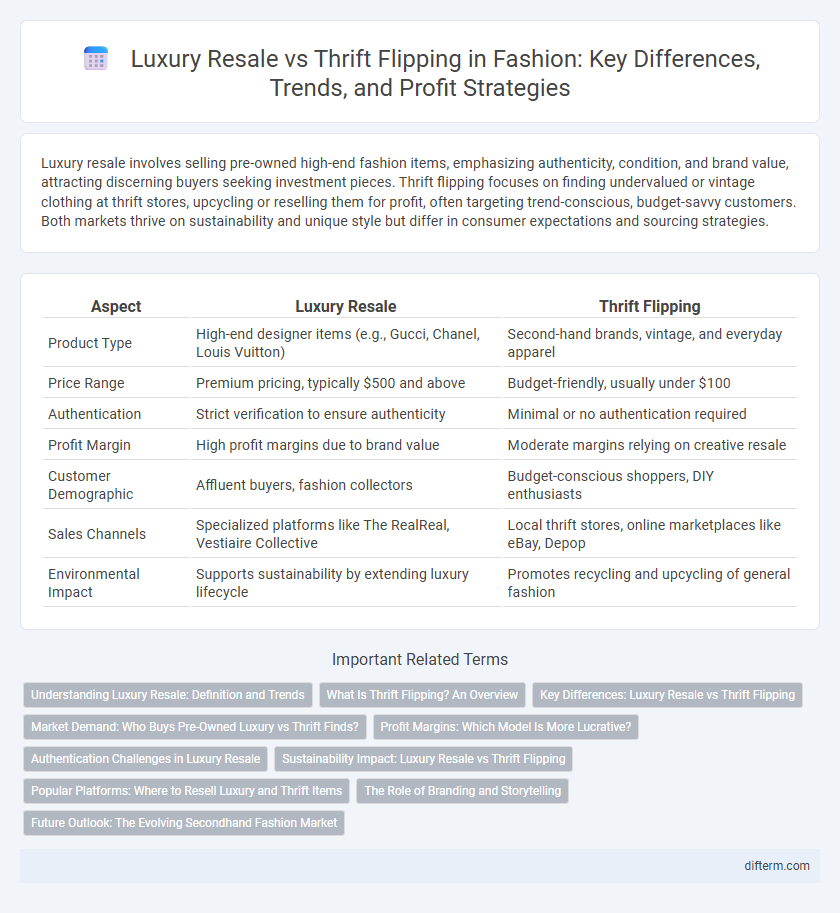Luxury resale involves selling pre-owned high-end fashion items, emphasizing authenticity, condition, and brand value, attracting discerning buyers seeking investment pieces. Thrift flipping focuses on finding undervalued or vintage clothing at thrift stores, upcycling or reselling them for profit, often targeting trend-conscious, budget-savvy customers. Both markets thrive on sustainability and unique style but differ in consumer expectations and sourcing strategies.
Table of Comparison
| Aspect | Luxury Resale | Thrift Flipping |
|---|---|---|
| Product Type | High-end designer items (e.g., Gucci, Chanel, Louis Vuitton) | Second-hand brands, vintage, and everyday apparel |
| Price Range | Premium pricing, typically $500 and above | Budget-friendly, usually under $100 |
| Authentication | Strict verification to ensure authenticity | Minimal or no authentication required |
| Profit Margin | High profit margins due to brand value | Moderate margins relying on creative resale |
| Customer Demographic | Affluent buyers, fashion collectors | Budget-conscious shoppers, DIY enthusiasts |
| Sales Channels | Specialized platforms like The RealReal, Vestiaire Collective | Local thrift stores, online marketplaces like eBay, Depop |
| Environmental Impact | Supports sustainability by extending luxury lifecycle | Promotes recycling and upcycling of general fashion |
Understanding Luxury Resale: Definition and Trends
Luxury resale involves the purchase and sale of pre-owned high-end designer items, catering to a market driven by demand for authentic, rare, and sustainable fashion products. This segment has experienced significant growth due to increased consumer awareness of sustainability, digital platforms facilitating authenticated transactions, and the rising value of vintage luxury pieces. Key trends include the expansion of online resale marketplaces, the prominence of designer brands like Chanel and Hermes, and the adoption of technology for authenticity verification to build customer trust.
What Is Thrift Flipping? An Overview
Thrift flipping involves purchasing undervalued secondhand clothing or accessories and creatively altering or upcycling them to increase their market value. This practice contrasts with luxury resale, which typically centers on authentic high-end designer items sold in their original condition. Thrift flipping leverages personalization and trend-driven modifications, making unique fashion pieces that capitalize on sustainability and creativity.
Key Differences: Luxury Resale vs Thrift Flipping
Luxury resale focuses on authenticated high-end designer items with established brand value, often sold through specialized marketplaces or boutiques. Thrift flipping involves purchasing undervalued, secondhand clothing from thrift stores or garage sales, then repairing or upcycling to increase resale value. The primary differences lie in product provenance, pricing strategy, and target consumer demographics.
Market Demand: Who Buys Pre-Owned Luxury vs Thrift Finds?
Pre-owned luxury buyers typically consist of affluent consumers seeking high-end brands like Chanel, Louis Vuitton, and Rolex, driven by authenticity, investment value, and exclusivity. Thrift flipping attracts budget-conscious shoppers and vintage enthusiasts hunting for unique, affordable fashion pieces with potential for profit through trend-driven demand. Market data reveals growing interest in sustainability and circular fashion, with luxury resale expected to reach $51 billion by 2025, while thrift flipping thrives in niche markets fueled by social media influence and DIY upcycling trends.
Profit Margins: Which Model Is More Lucrative?
Luxury resale consistently yields higher profit margins due to the premium pricing of authenticated designer items and a targeted affluent customer base. Thrift flipping often involves lower upfront costs, but profit margins are slimmer because of the unpredictable quality and consumer demand. Data shows luxury resale platforms can achieve margins upwards of 60%, whereas thrift flipping margins typically range between 20-40%.
Authentication Challenges in Luxury Resale
Authentication challenges in luxury resale revolve around verifying the originality of high-end designer items, which requires expert knowledge of brand-specific details such as serial numbers, holograms, and unique stitching patterns. Counterfeiters continuously improve their techniques, making it difficult to distinguish genuine products from fakes without specialized authentication services or advanced technology like blockchain and AI. These challenges often lead to consumer mistrust and impact resale value, emphasizing the importance of reliable verification processes in maintaining brand integrity.
Sustainability Impact: Luxury Resale vs Thrift Flipping
Luxury resale extends the life cycle of high-end garments by promoting the reuse of premium materials, significantly reducing textile waste and the carbon footprint associated with new luxury production. Thrift flipping involves creatively upcycling affordable secondhand clothes, contributing to sustainability by diverting massive volumes of fast fashion from landfills and reducing demand for virgin fabrics. Both practices advance circular fashion models, yet luxury resale often achieves higher environmental impact per item due to the intrinsic value and durability of luxury fabrics.
Popular Platforms: Where to Resell Luxury and Thrift Items
Vestiaire Collective and The RealReal dominate luxury resale, offering authenticated designer pieces with a global reach, while Poshmark and Depop excel in thrift flipping by catering to younger audiences seeking unique, affordable vintage finds. eBay remains a versatile platform supporting both luxury and thrift markets, providing extensive listings and competitive pricing. Grailed specializes in high-end streetwear, making it a niche favorite for reselling luxury casual wear.
The Role of Branding and Storytelling
Luxury resale leverages powerful brand recognition and authentic storytelling to enhance perceived value and justify premium pricing, attracting discerning consumers seeking exclusivity. Thrift flipping relies on creative narratives and personal curation to transform low-cost vintage or secondhand items into unique fashion statements with increased appeal. Both approaches utilize compelling branding and storytelling to connect emotionally with buyers, driving demand and market differentiation.
Future Outlook: The Evolving Secondhand Fashion Market
The future outlook of the secondhand fashion market highlights luxury resale as a rapidly expanding segment driven by growing consumer demand for authentic, high-end brands paired with digital platform innovations. Thrift flipping continues to attract eco-conscious shoppers seeking affordable, unique styles, but faces challenges in scalability and consistent quality control. Emerging technologies like AI-powered authentication and augmented reality are poised to enhance transparency, trust, and customer experience across both luxury resale and thrift flipping sectors.
Luxury resale vs thrift flipping Infographic

 difterm.com
difterm.com